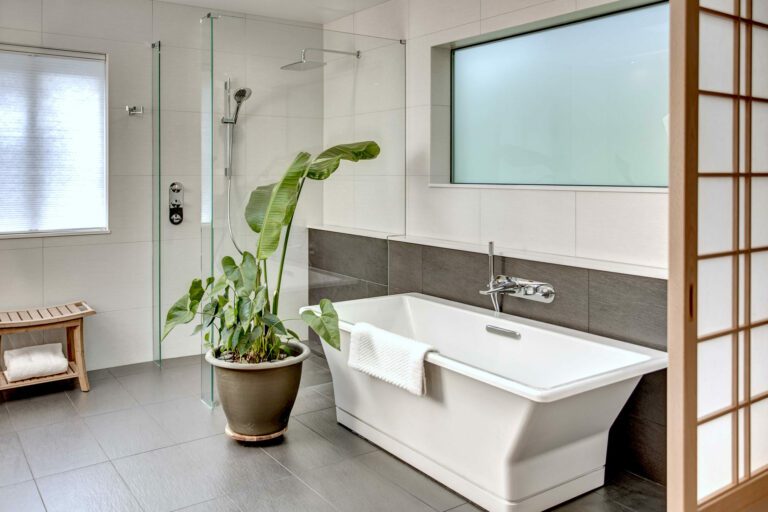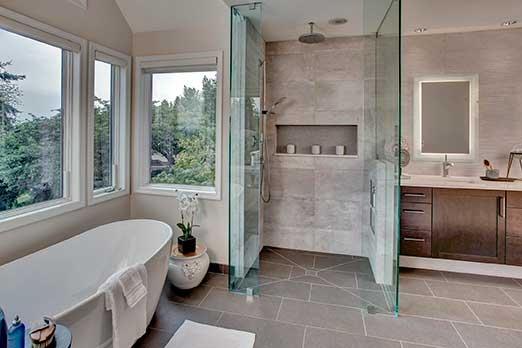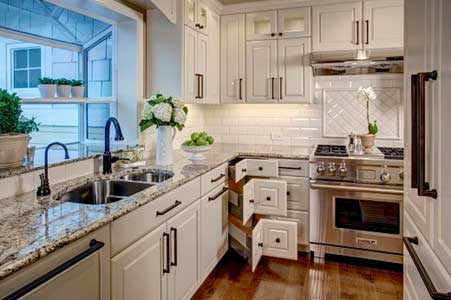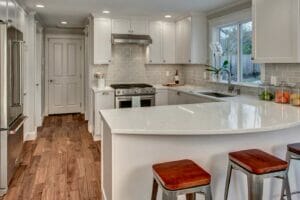The concept of aging in place is not a new one. The trend has developed over the last several decades. There has, however, been renewed interest and a surge in demand for remodels that include updates making it easier for the homeowner to remain in their home long term. April is a Certified Aging-in-Place Specialist (CAPS) and works closely with homeowners throughout the Eastside to make sure the changes we make will be ones that make it safer and easier for them to remain in their homes – without compromising aesthetics.
Bathroom Remodeling Aging in Place
When remodeling with aging in place in mind, one of the most common rooms that needs to be addressed is the primary bathroom. As we age and lose mobility, stepping in and out of a tub becomes not just difficult but often dangerous. In many of our remodels, we replace the tub with a walk-in shower. In other bathroom remodels, we maintain the tub but add a separate walk-in shower so that there will be options for now and later.

Making the Bathroom Safer
Remodeling a bathroom for aging in place involves making thoughtful design choices that prioritize safety, accessibility, and comfort for individuals as they age. Here are key considerations to keep in mind:
Safety Features
- Non-slip flooring: Choose non-slip materials for the floor to prevent falls.
- Grab bars: Install grab bars near the toilet, shower, and bathtub to provide support and balance.
- Shower seats: Include a built-in or fold-down shower seat to allow for seated bathing.
- Scald prevention: Use anti-scald devices on faucets and showerheads to prevent burns.
Accessibility
- Walk-in shower: Consider a curbless or low-threshold shower to eliminate the need to step over a barrier.
- Wide doorways: Ensure doorways are at least 32-36 inches wide to accommodate walkers or wheelchairs.
- Lever-style handles: Replace traditional doorknobs and faucet handles with lever-style handles, which are easier to operate for those with limited hand strength.
- Adjustable showerheads: Install handheld, adjustable-height showerheads for greater control and flexibility.
Comfort and Convenience
- Raised toilet seats: Opt for a comfort height toilet, which is taller than standard models and easier to sit on and stand up from.
- Ample lighting: Enhance lighting with bright, glare-free options, including night lights, to improve visibility.
- Storage accessibility: Design storage solutions that are within easy reach, such as pull-out shelves and drawers.
- Heated elements: Consider installing heated floors and towel racks for added comfort.
Functional Design
- Space planning: Ensure there is enough space for maneuvering, particularly if using mobility aids.
- Clear pathways: Keep pathways clear of obstacles and ensure that the layout allows for easy movement.
- Sit-down vanity: Include a sit-down vanity area to make grooming tasks more manageable.
Technology Integration
- Emergency alert systems: Install emergency call buttons or a monitoring system for quick access to help if needed.
- Voice-activated controls: Incorporate smart home technology, such as voice-activated lights and fixtures, for added convenience.
Durability and Maintenance
- Easy-to-clean surfaces: Choose materials that are easy to clean and maintain, reducing the need for strenuous upkeep.
- Waterproofing: Ensure that all areas are well-sealed and waterproofed to prevent water damage and mold growth.
By addressing these considerations, you can create a bathroom that is safe, accessible, and comfortable for aging in place, allowing for greater independence and peace of mind.
For some homeowners, you may anticipate the need for wider doors and hallways to accommodate a wheelchair. For others, you may find it sufficient to add the walk-in shower and a few logically placed grab bars to keep you safe and steady. Before beginning any project, we’ll talk in detail about what you want and what you think you’ll need to remain in your home safely and comfortably.

Regardless of the design changes necessary in your home, there are options for making changes without sacrificing the style and beauty of the space. From handheld showerheads to built-in shower chairs to lowered countertops, we help homeowners design a space in which they can thrive and truly enjoy.
Beyond the Bathroom Remodel
While most of the attention is placed on the bathroom when talking about aging in place, there are other challenges.
Making Aging in Place Safe, Convenient, and Lasting
Consider areas of the home with tight corners or stairways. Think about kitchen storage and how the tallest cupboards may result in items being out of reach. There are solutions for nearly any obstacle to remaining at home, including elevators that provide access to other floors and pull-out drawers in lower cupboards that make it easier to retrieve items without excessive reaching or bending over.

There are many benefits to updating your home that allow for aging in place, not the least of which is cost. Enjoying the investment you’ve made in your home, remaining in the neighborhood where you’ve created memories and friendships, and being able to retire in comfort and style are only a few of the reasons to consider remodeling and aging in place. Our overall goal is to make living at home safe and comfortable for many years to come – without sacrificing style and beauty.
If you feel that making updates to your home will make it easier for you to remain in place as you age, please get in touch. We can help guide you through the design process and make decisions about your remodel that factor in what you may need in the future. Get in touch!



